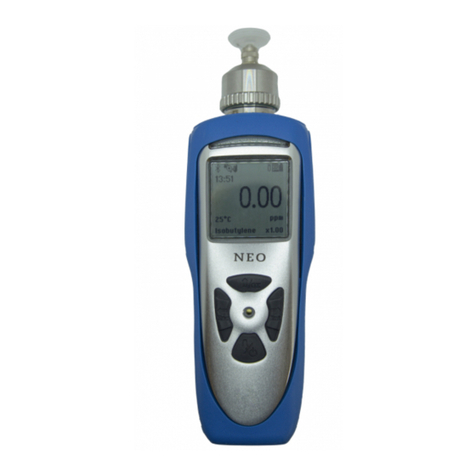
3
READ BEFORE OPERATING
This manual must be carefully read by all individuals who have or will have the responsibility of using,
maintaining, or servicing this product. The product will perform as designed only if it is used, maintained,
and serviced in accordance with the manufacturer’s instructions. The user should understand how to set
the correct parameters and interpret the obtained results.
DESCRIPTION
The NEO is one of the most advanced handheld VOC (Volatile Organic Compound) monitors available for
ppb (parts per billion) detection. The NEO offers several models from the most sensitive 1 ppb to a high
range up to 15000 ppm for different applications and user selections. Novel designs of the photo-ioniza-
tion detector (PID) and ultraviolet (UV) lamp provide outstanding sensitivity, stability and reproducibility.
Options include real time data monitoring with a built-in wireless modem using WatchGas Suite applicati-
on software.
CAUTION
To reduce the risk of electric shock, turn the power off before removing the instrument cover. Disconnect
the battery before removing sensor module for service. Never operate the instrument when the cover is
removed. Remove instrument cover and sensor module only in an area known to be non-hazardous.
SPECIAL NOTES
• When the instrument is taken out of the transport case and turned on for the first time, there may be
some residual organic or inorganic vapor trapped inside the detector chamber. The initial PID sensor
reading may indicate a few ppm. Enter an area known to be free of any organic vapor and turn on the
instrument. After running for several minutes, the residual vapor in the detector chamber will be cleared
and the reading should return to zero.
• The battery of the instrument discharges slowly even if it is turned off. If the instrument has not been
charged for 5 to 7 days, the battery voltage may be low. Therefore, it is good practice to fully charge
the instrument for at least 10 hours before the first use and to charge before each day’s use. It is also
recommended Refer to this User Guide’s section on battery charging for more information on battery
charging and replacement.
• Do not remove the filter when the instrument is on, otherwise, dust entry will reduce the accuracy of
measurement, shorten the life of the sensor, and possibly damage the sensor.
WARNINGS
STATIC HAZARD: Clean only with a damp cloth.
For safety reasons, this equipment must be operated and serviced by qualified personnel only. Read and
understand the instruction manual completely before operating or servicing.
• Use only WatchGas battery pack M011-3002-000. Substitution of components may impair intrinsic
safety. Recharge batteries only in non-hazardous locations.
• Do not mix old and new batteries or batteries from different manufacturers.
• For maximum safety, the accuracy of the instrument should be checked by exposing it to a known
concentration calibration gas before each day’s use.
• Do not use USB/PC communication in a hazardous location.






























